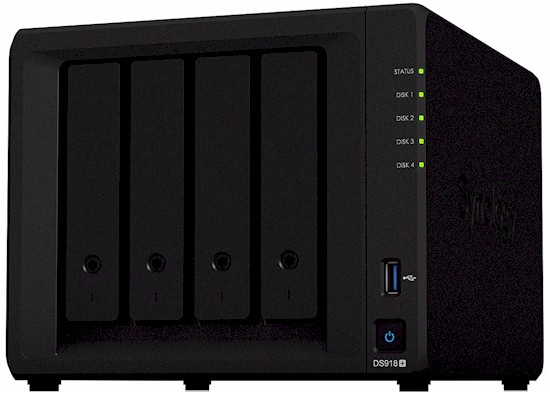
| At a glance | |
|---|---|
| Product | Synology 4-bay NAS DiskStation (DS918+) [Website] |
| Summary | Four-bay RAID 5 class NAS powered by quad-core Intel Celeron CPU with upgradeable 4 GB RAM, dual gigabit Ethernet ports and two M.2 SSD drive slots |
| Pros | • BTRFS filesystem with snapshots available • Supports 4K H.264/H.265 online transcoding • Supports up to two M.2 NVMee 2280 SSD modules without occupying internal drive bays |
| Cons | • Expensive • No 10 GbE support |
Typical Price: $1000 Buy From Amazon
Introduction
In this review, I’ll be looking at the Synology DS918+ DiskStation. Synology describes the Plus Series as “Engineered for high-performance and data-intensive tasks, designed to meet on-the-fly encryption and scalability demands”. That description perfectly describes the DS918+.
I’m going to compare the DS918+ with the recently reviewed DS418j. It might seem counterintuitive to compare the Plus series DS918+ to the entry-level DS418j, but it’s not. While the DS918+ costs almost twice as much ($550) as the DS418j, both products earned excellent rankings in our NAS Ranker.
The chart below, generated from the NAS Finder, compares the major features of the two Synology NASes. You can see the DS918+ has a significantly beefier hardware lineup across the board. Its platform includes a quad-core Celeron J3455 processor with 4 GB of RAM (upgradeable to 8 GB), dual Gigabit Ethernet ports with load balancing and failover and an eSATA port that enables expansion to 9 bays total with the addition of the DX517 expansion chassis.
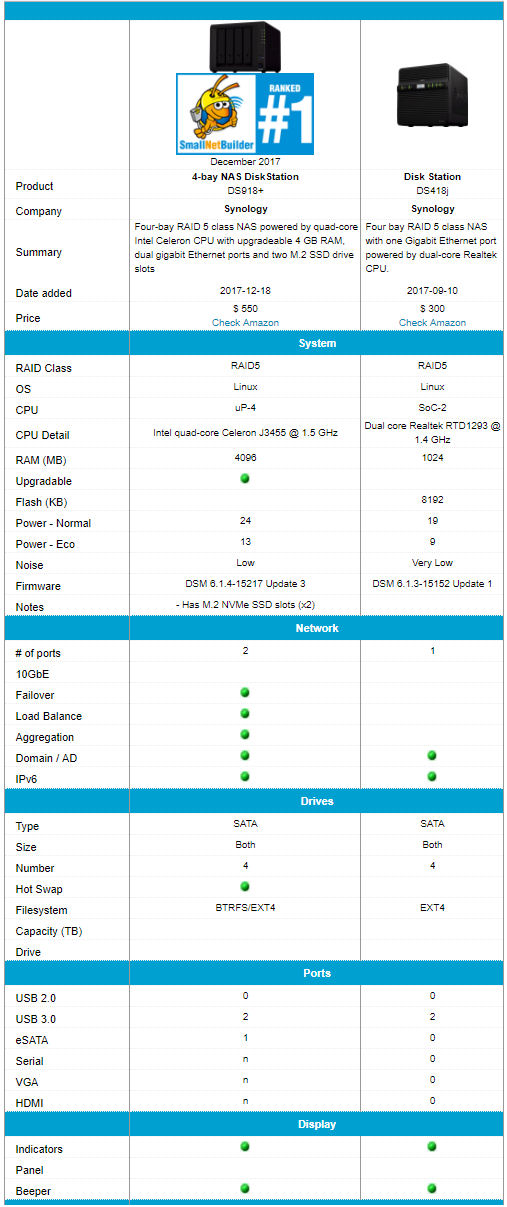
Synology DS918+ and Synology DS418j feature comparison
The drives are hot-swappable and the DS918+ also has two slots for M.2 NVMe SSD cards, so you don’t have to give up drive bays to get SSD caching. If you want to read about the performance benefits of SSD caching, Synology’s white paper is well worth reading.
By comparison, the DS418j is powered by a dual-core Realtek processor and has 1GB of non-upgradeable memory. It has a single Gigabit Ethernet port, the drives are not hot-swappable and lacks an eSATA port for expansion or backup.
As with most of Synology’s higher-end NASes, the DS918+ supports the BTRFS file system in addition to the standard EXT4 file system. The BTRFS file system allows you to create up to 256 recovery points with very little storage overhead. Synology’s BTRFS white paper has more info.
The callouts and LED indicator key chart below shows the front and rear panel layouts for the DS918+. The front panel has a single status indicator and has indicators for the four disks. There’s a single USB 3.0 port on the front panel as well as the power button. The rear panel has dual Gigabit Ethernet ports, each with status indicator LEDs, an eSATA port, the second USB 3.0 port, and a power port.
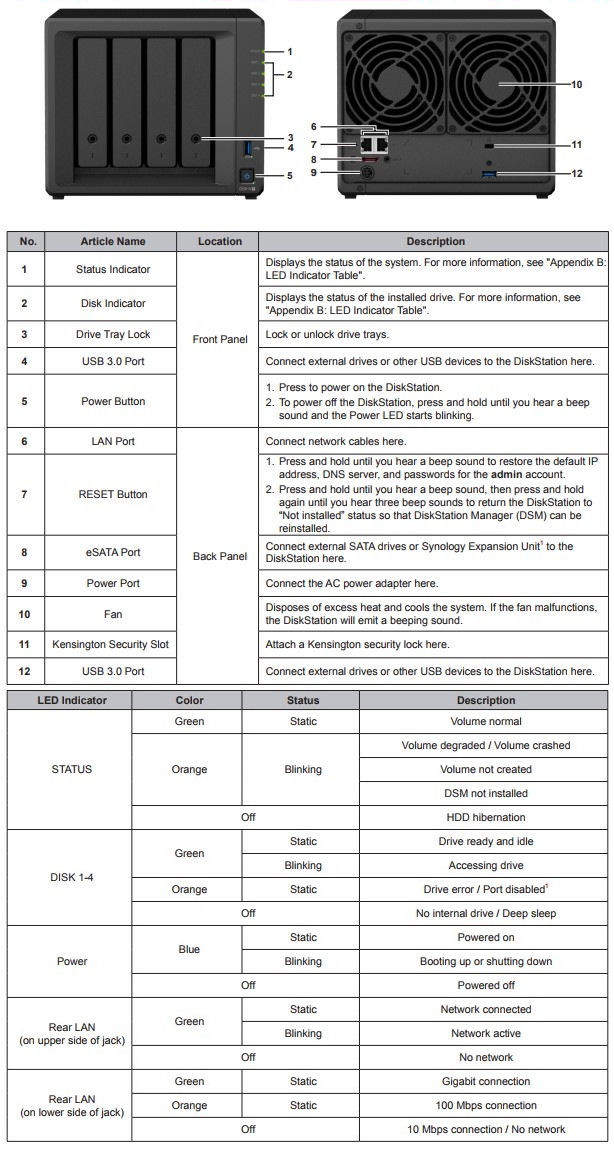
Synology DS918+ Front & Rear panel callouts and LED indicator key
For 3.5″ drives, you don’t need any tools for installation. You just remove the lockable drive trays and secure the drives in the drive tray with plastic fastening panels that snap into place. Disk installation is covered in the Hardware Installation guide.
Inside
The disassembly of the DS918+ proved to be a bit challenging so we don’t have a photo of the main PCB. However, iFixit has a complete teardown of the DS918+. The screenshot below was taken from Step 19 of their teardown.
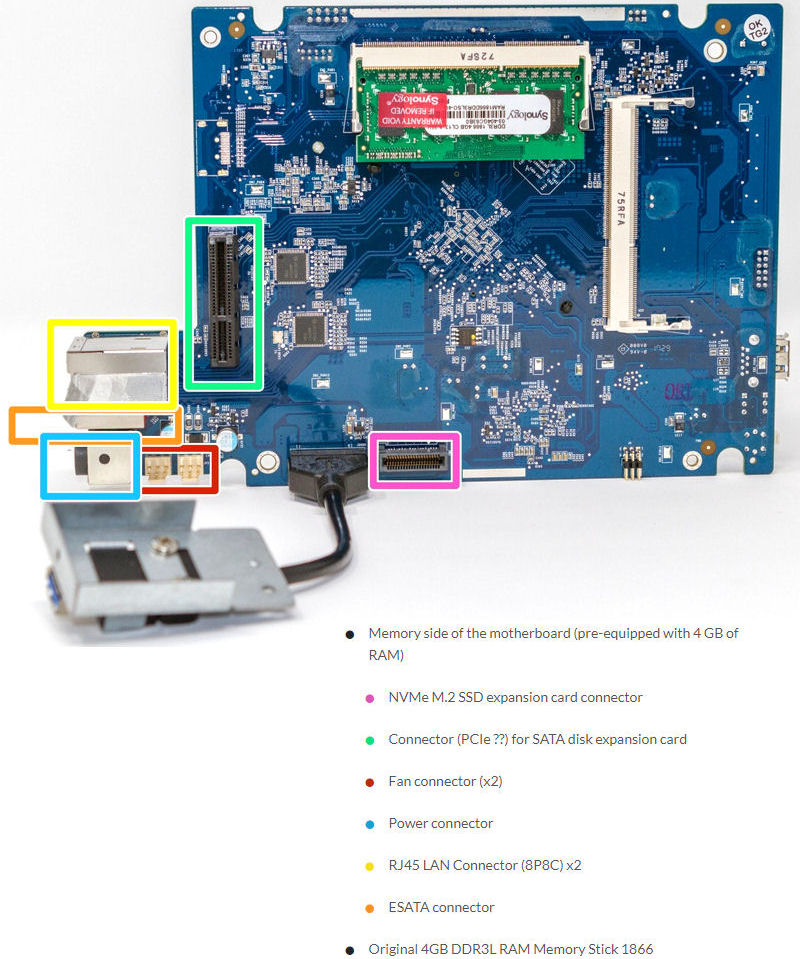
Synology DS918+ PCB from IFIXIT’s teardown
(Courtesy of iFixit)
Even though disassembly of the DS918+ was moderately difficult, Synology made it fairly simple to upgrade the memory without case disassembly. You can access the empty memory slot by removing the drives. This is covered on pages 8-9 of the Hardware Installation guide.
Note: If you upgrade the memory after you have initialized, be sure to label your drives so that you can re-insert them in the correct order.
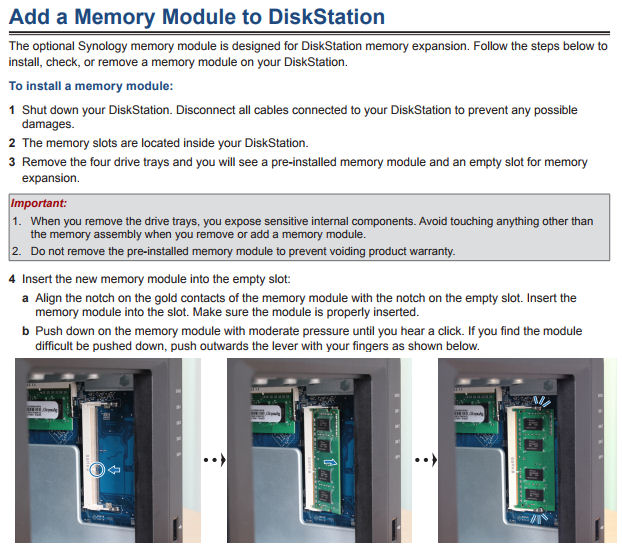
Synology DS918+ memory expansion
Similarly, Synology made it simple to add one or two M.2 NVMe SSD modules to the DS918+. The SSD slots are located on the bottom of the DiskStation. Page 10 of the Hardware Installation guide walks you through the upgrade process.
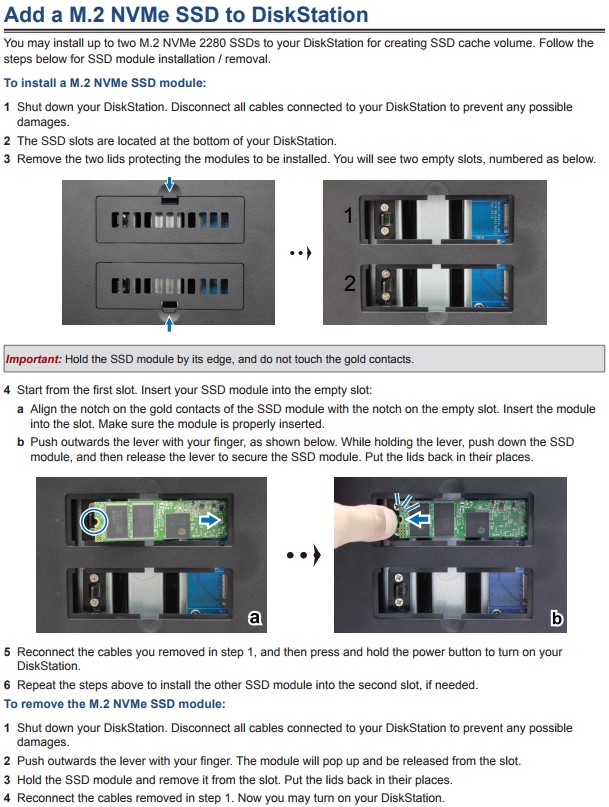
Synology DS918+ Add M.2 NVMe SSD modules
The DS918+ drew 26 W with four of our stock WD Red 1 TB (WD10EFRX) spun up and 13 W in power save mode with the drives spun down. Fan and drive noise was rated very low. RAID 5 build took 2 hours and 10 minutes with bad block check skipped.
Features
As noted in the recent previous Synology product reviews, all of Synology’s NASes operate using DiskStation Manager 6. DSM 6.1 provides a common set of features and a consistent user interface across all of Synology’s products. Of course, some higher-end products support enhanced features, such as the BTRFS filesystem that isn’t supported on J Series and Value Series products.
If you want to take the user interface for a test drive, Synology has a live demo of the beta version of DSM 6.2. Of course, some admin features and well as cloud storage and file synchronization are disabled in the demo.
You can also browse through the video tutorials in their Knowledge Base, or download the DSM 6.1.4 User’s Guide.
The screenshot below shows the DSM 6 control panel along with the performance widget running on the desktop. This was created from the online DSM 6.2 beta.
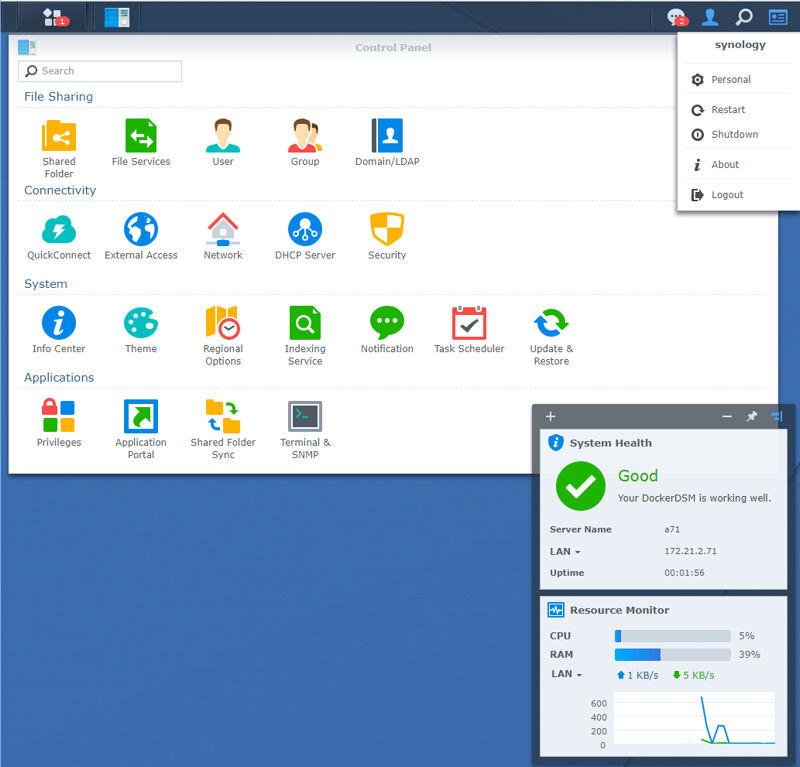
Synology DSM 6.1 Control Panel
Performance
DSM 6.1.4-15217 Update 3 firmware was loaded onto the DS918+ and performance tests were run using the Revision 5 NAS test process. All tests were run using Western Digital Red 1 TB WD10EFRX (x4 SNB supplied). Performance tests were run using the EXT4 filesystem. As noted earlier, I’ll be comparing against the DS418j.
File copy Write and File Copy Read results were consistent across all RAID levels (RAID 0, 5, & 10) for both NASes. All results were above 100 MB/s and approaching the theoretical limit of single client testing on a single Gigabit connection. The exception was the DS418j’s RAID 5 File Copy Write performance of 94.9 MB/s.
In general, the DS918+ outperformed the DS418j on most of the NASPT tests with the exception of the NASPT File Copy From NAS where the DS418j held a slight edge for all RAID levels.
Neither NAS has USB 2.0 ports, so no USB 2.0 backup tests were run. The DS918+ has an eSATA port and those results were similar to the USB 3.0 results for the DS918+. For the USB 3.0 backup tests, the Network backup tests and the iSCSI read and write tests, the DS918+ outperformed the DS418j, with the exception of the USB 3.0 FAT format backup test.
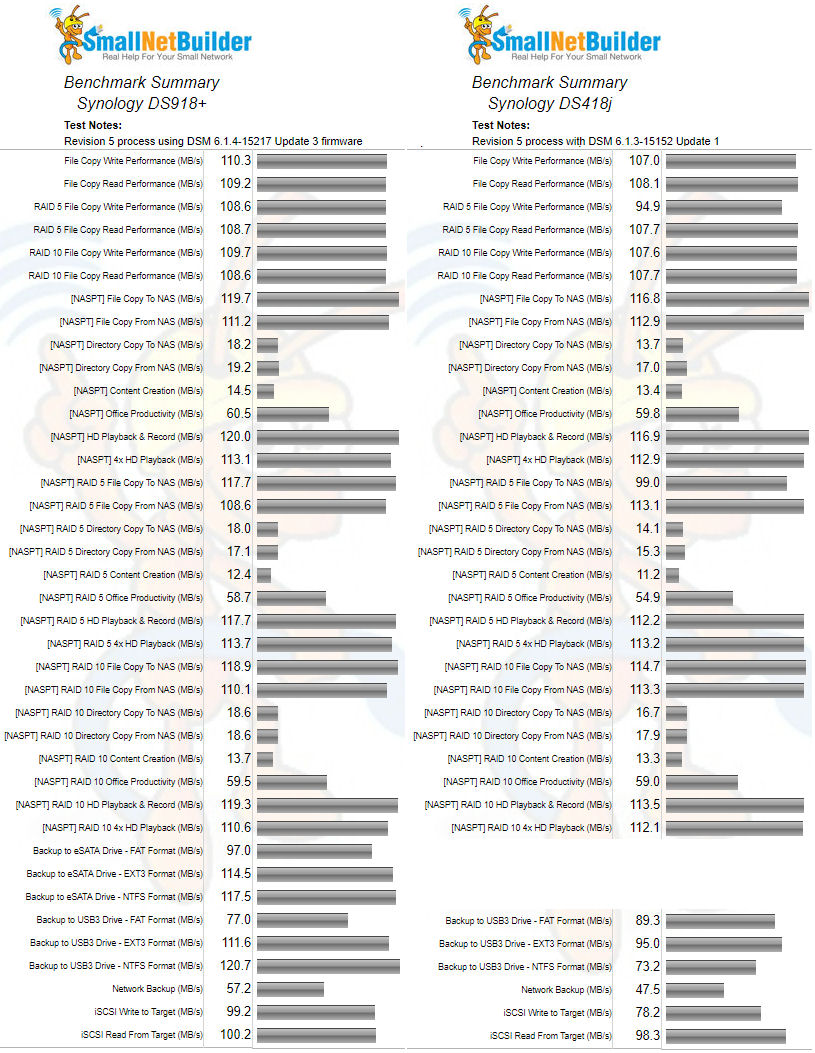
Synology DS918+ and DS418j Benchmark summary comparison
Using the NAS Ranker, I filtered for RAID5 class products, Test Method 5 and sorted by rank. The chart below shows the top three ranked NASes, with the DS918+ in #1 and DS418j in #3.
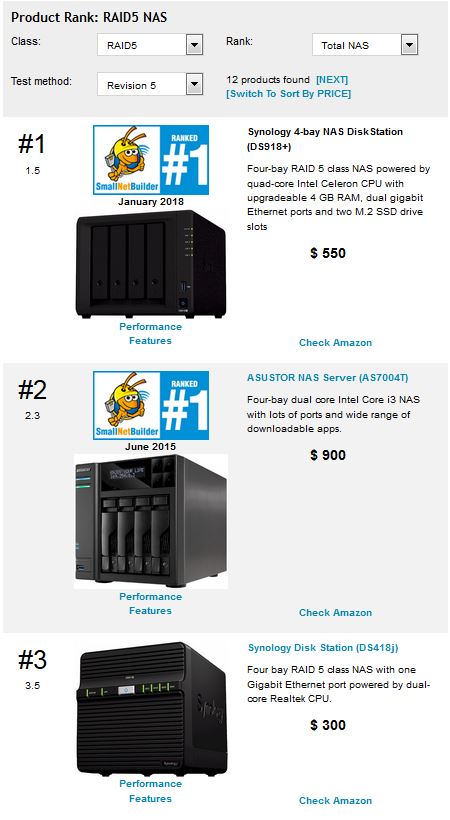
TOTAL NAS Rank for RAID5 test method Revision 5 NASes
Looking at the Ranker performance summaries, the DS918+ had category wins for every category except for Read Benchmarks. The DS418j just barely edged out the DS918+ largely because it had better NASPT File Copy From NAS scores. The DS918+ had significantly better category rankings for Write Benchmarks, Mixed Read Write, Backup and iSCSI categories.
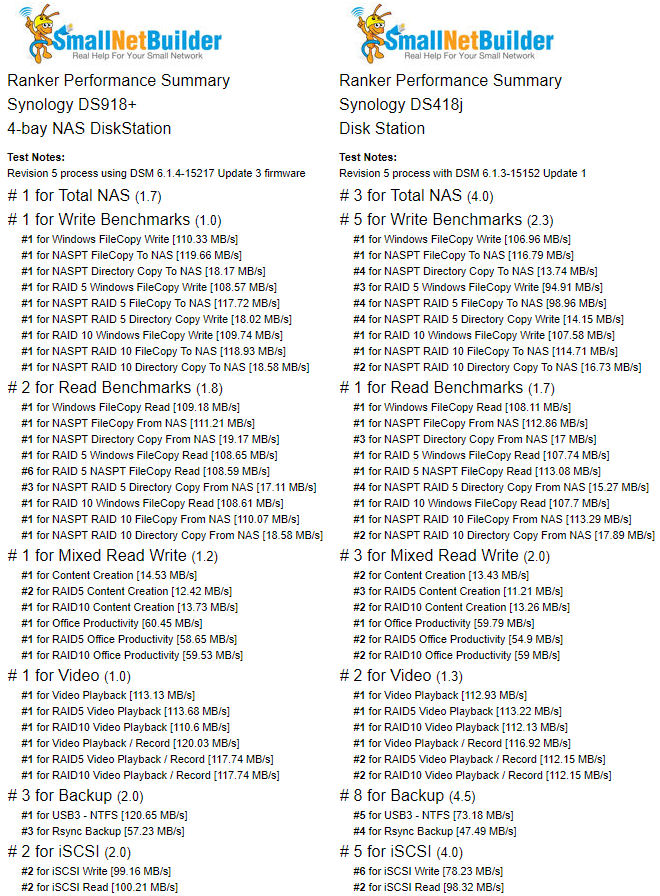
Ranker Performance Summary comparison of the Synology DS918+ and the Synology DS418j
Closing Thoughts
The Synology DS918+ and the DS418j DiskStations are very different devices, yet both scored well in our Total NAS rankings, finishing #1 and #3 respectively. The main reason for this is that our benchmarks don’t include things that benefit from the 918+’s extra processing power, namely encrypted folders and media transcoding.
Synology’s published performance results include encryped folder performance, but not transcoding. They also use multiple aggregated ports for the sequential throughput test on NASes that have them and use Core i7 machines with a RAID0 SSD volume as clients, (but don’t say how many machines are used). You can look through Synology’s results and see if you think you can achieve similar results with your LAN devices. In most cases, we think not. One Synology benchmark most similar to our Windows filecopy test is shown below to provide a taste of Synology’s benchmarking results.
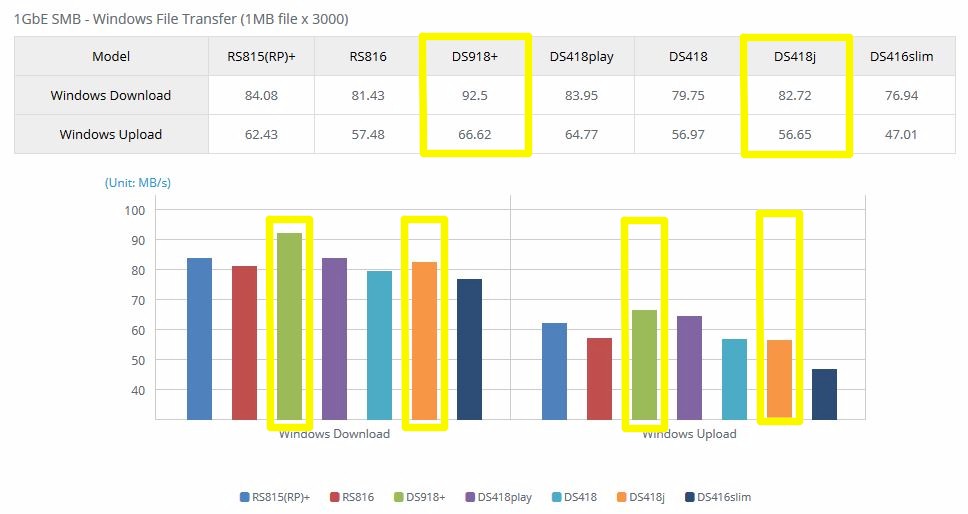
Synology benchmark – Windows file transfer
In the end, the DS918+lacks something that would provide benefit to folks who don’t run lab-grade computers: a 10 GbE port. A bigger pipe would allow even single machines to break through the 125 MB/s barrier imposed by a single Gigabit Ethernet port—no link aggregation required!
But Synology currently has no 10 GbE capable four-port NASes, while QNAP has three four-bays with built-in 10GbE and three with 10 GbE options. Of those, we’ve tested the four-bay TVS-471 and five-bay TS-563, which outrank the DS1817 and four-bay TS-453B and TS-431X that do not.
Synology’s least expensive 10 GBE options are the $849 eight-bay DS1817 with two built-in 10GbE copper ports and $789 five-bay DS1517+, which requires a 10 GbE board that brings total cost up over $1000. The DS1517+ ranks #1 in our NAS Ranker’s RAID5-10GbE class, while the DS1817 ranks #5.
As a high-end four bay NAS, the DS918+ has most everything you could want, but at a premium price:
- Chart-topping performance
- Expandability to 9 bays
- 4K to 1080p real-time transcoding
- Hardware-based encryption with no performance hit
- BTRFS filesystem for granular snapshot-based backups
- Support for SSD caching to boost performance
But if you’re just looking for a RAID5 capable NAS capable of maxing out a single Gigabit Ethernet connection, the $300 DS418j would be a better way for you to give Synology your money.
